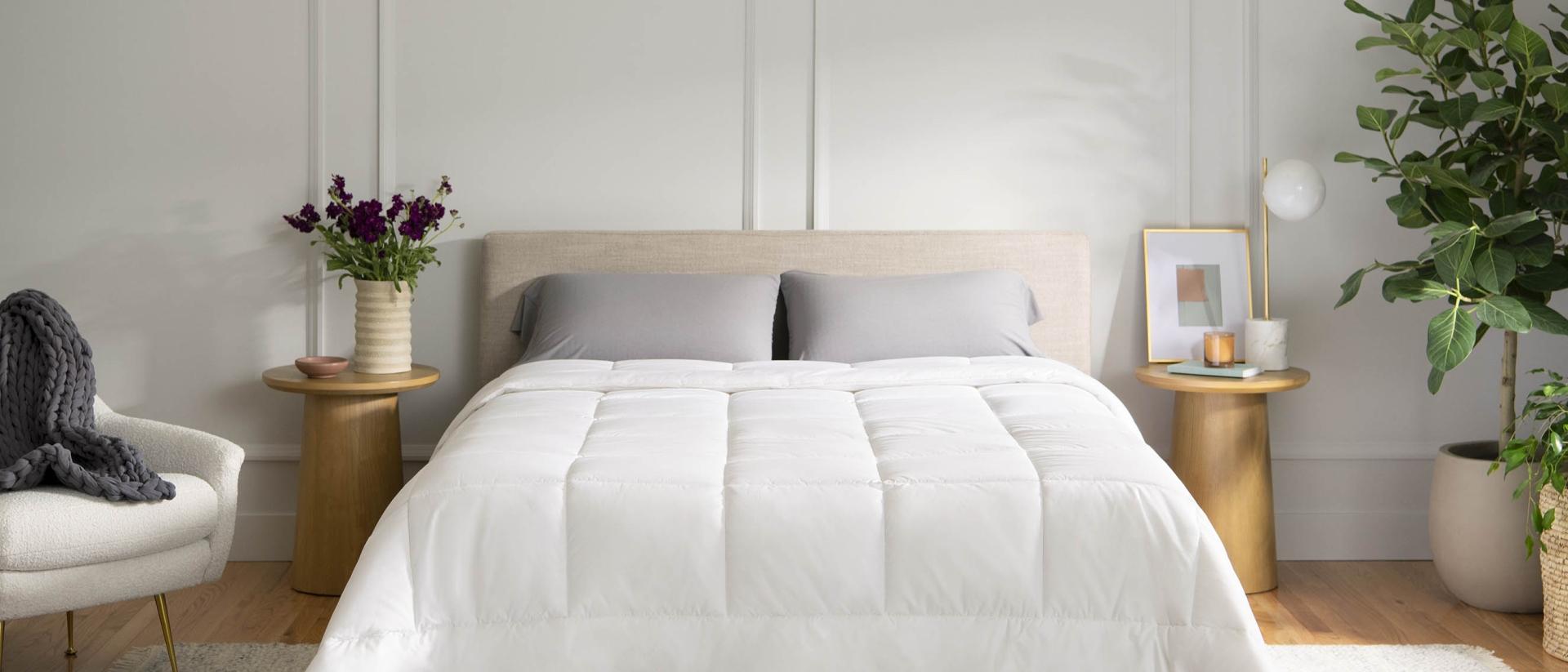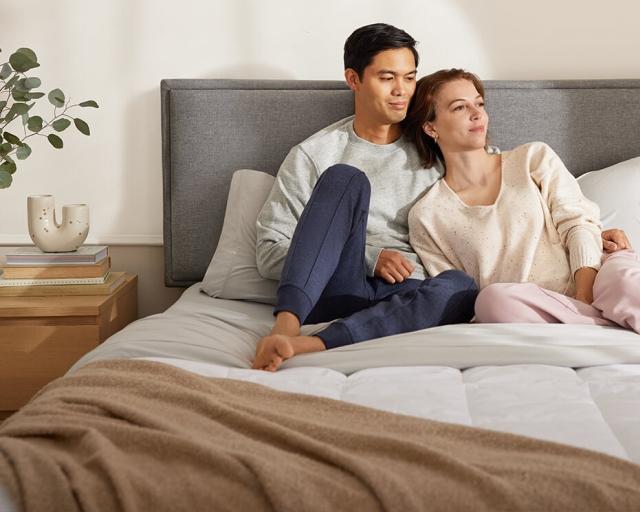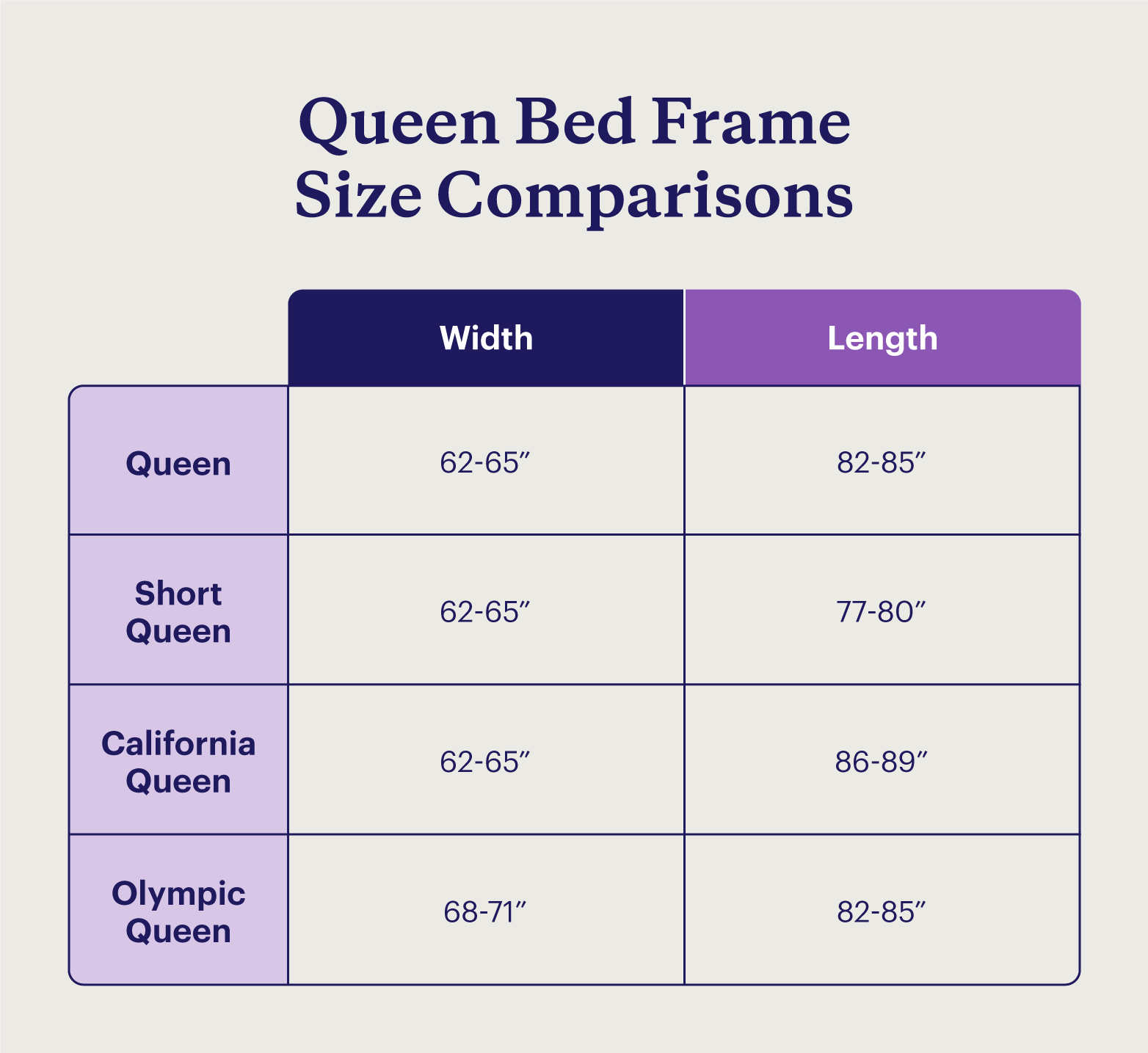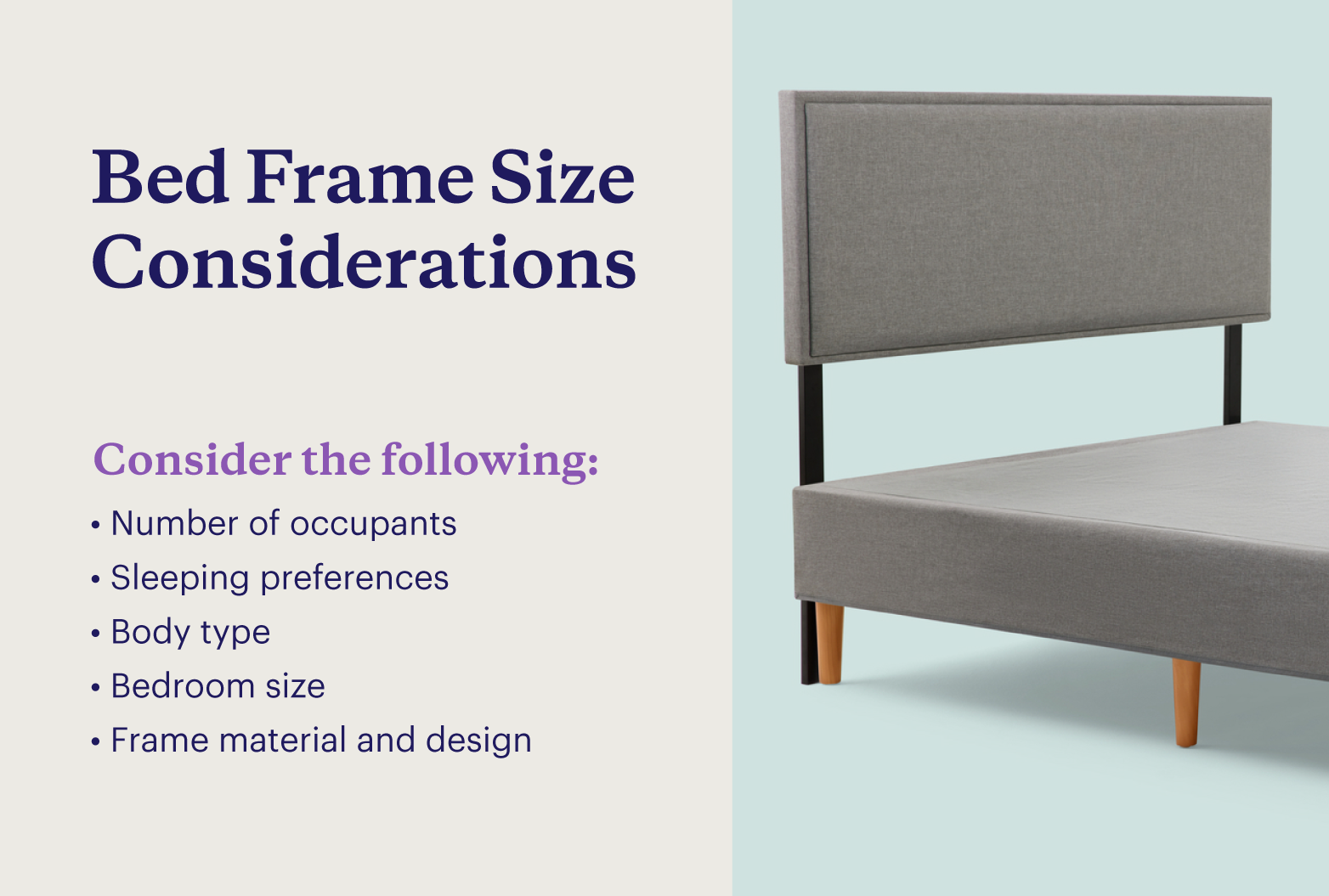
Queen Bed Frame Dimensions Guide (+ Sizing Chart)
Standard queen mattresses measure 60 inches wide by 80 inches long. Queen bed frames add an additional 2 to 5 inches in width and length, making queen bed frame dimensions 62-65 inches by 82-85 inches.
If you’re deciding which mattress size is best for you, you must also consider the bed frame’s dimensions to ensure it fits in your bedroom.
Outperforming the king-size in popularity, queen-size mattresses make a great option for couples who don’t have the extra space or desire for an extra large bed. It’s also an excellent choice for single sleepers who enjoy added space. So how wide is a queen bed?
A standard queen mattress measures 60 by 80 inches, and queen bed frame dimensions add 2 to 5 inches to the width and length of a queen mattress. This difference might seem insignificant, but it could make a queen bed a tight fit in a smaller bedroom or appear too small in a large primary bedroom.
Read along to compare standard queen bed frame dimensions to other sizes on the market and to understand the considerations for buying a queen bed frame.
What Are the Dimensions of a Queen-Size Bed and Frame?
Queen beds are the most popular mattress size among adults in the U.S.
A standard queen-size mattress measures 60 by 80 inches. The foundation portion of a queen bed frame must match at least how wide a queen bed is. However, depending on the material and style, bed frames add an extra 2 to 5 inches to the mattress’s dimensions. More often than not, a bed frame will be 62-66 x 82-86 inches.
Be sure to account for the bed frame’s extra space when planning out your bedroom layout to ensure your room can accommodate this size bed frame. Keep in mind that bed frame dimensions can vary slightly from brand to brand.
What Size Is a Queen Headboard?
On average, a queen headboard size is 62 inches wide and 28 inches tall. Queen headboards must at least match how wide a queen bed is at 60 inches. However, many bed frames and attached headboards extend an extra inch or two on each side of the mattress.
A headboard’s style and shape influence its size, particularly its height. For example, poster headboards stretch taller than ones with slats. Headboards are made in low (up to 12 inches), tall (up to 70 inches), and adjustable profiles. Each height offers an entirely different aesthetic.
Compare All Mattress and Bed Frame Sizes
What makes queen-size beds and frames different from other mattress and bed frame sizes on the market? The chart below allows you to easily compare.
Size | Mattress Dimensions | Bed Frame Dimensions | Comfortably Fits |
| Twin | 38” x 75” | 40-43” x 77-80” | Single sleepers or children |
| Twin XL | 38” x 80” | 40-43” x 82-85” | Single sleepers or tall children |
| Full | 54” x 75” | 56-59” x 77-80” | Adults with smaller body types — single or couples — or older children |
| Queen | 60” x 80” | 62-65” x 82-85” | Adult single sleepers or couples, including small pets |
| Short queen | 60” x 75” | 62-65” x 77-80” (not commonly available) | Short adults — single or couples |
| California queen | 60” x 84” | 62-65” x 86-89” (not commonly available) | Tall adults — single or couples — including pets |
| Olympic queen | 66” x 80” | 68-71” x 82-85” (not commonly available) | Adults with larger body types — single or couples — including pets |
| Super king | 72” x 78” | 74-77” x 80-83” | Couples, including pets and/or small children |
| King | 76” x 80” | 78-81” x 82-85” | Couples, including pets and/or children |
| California king | 72” x 84” | 74-77” x 86-89” | Tall couples, including pets and/or children |
Queen vs. Full Bed Frame
Queen-size mattresses are larger than full beds. Compared to a queen, a full-size bed is 6 inches narrower and 5 inches shorter. This equates to 750 square inches less sleeping space.
Full bed dimensions:
- Mattress: 54 by 75 inches
- Frame: 56-59 by 77-80 inches
Full-size beds are best for single sleepers with small rooms or as starter mattresses for young adults moving into their first homes. If the bedroom allows, older children or kids with larger frames may find full-size beds more comfortable.
Queen vs. Short Queen Bed Frame
Short queen beds feature the same width as a standard queen but are slightly shorter. Short queen beds have 300 square inches less sleeping real estate compared to the queen.
Short queen bed dimensions:
- Mattress: 60 by 75 inches
- Frame: 62-65 by 77-80 inches
This mattress size works best for short adults, whether as a single sleeper or couple, and in smaller primary bedrooms. Otherwise, one of the most common places to find short queen beds is inside an RV — many RV mattresses are short queens that lay atop built-in bed frames.
Queen vs. California Queen Bed Frame
A California queen bed matches the width of a queen mattress but differs in length. Compared to the queen, California queen mattresses offer more legroom.
California queen bed dimensions:
- Mattress: 60 by 84 inches
- Frame: 62-65 by 86-89 inches
The extra length makes California queen beds a great option for individuals over 6 feet tall, leaving plenty of room at the foot of the bed for a pet or two. However, California queen bed frames are not commonly sold in retail stores and typically require custom building.
Queen vs. Olympic Queen Bed Frame
The difference between a queen and an Olympic queen mattress comes down to width. Olympic queens are 6 inches wider than queens.
Olympic queen bed dimensions:
- Mattress: 66 by 80 inches
- Frame: 68-71 by 82-85 inches
Olympic queen mattresses hit the market in the late 1990s, but are quite hard to find, as they are considered a novelty mattress size. You will likely have to build or order a custom bed frame if you want an Olympic queen for your home.
Queen vs. Super King Bed Frame
Queen-size beds are closer in size to super king beds vs. standard kings. Despite its name, super king beds are slightly smaller than king-size beds. Compared to queens, super kings offer an extra foot of sleeping space in width but 2 inches less in length.
Super king bed dimensions:
- Mattress: 72 by 78 inches
- Frame: 74-77 by 80-83 inches
Super king-size beds aren’t as common as the smaller queen and larger king-size beds. They are usually found in specialty stores or made to order online, making super king bed frames difficult to find.
As an in-between size, super-kings are another excellent option for those who want to make the most out of a small bedroom. The biggest drawback, however, is the lack of options — not just in terms of bed frames but with mattresses and bedding as well.
Queen vs. King Bed Frame
The main difference between a queen and a king bed is, again, width. A king bed frame dimensions measure about 16 inches wider than queen-size beds, offering 1,280 square inches more sleeping space. They do, however, have the same length.
King bed dimensions:
- Mattress: 76 by 80 inches
- Frame: 78-81 by 82-85 inches
Some sleepers choose queen-size beds over king-size beds because they don’t require as much space. Unlike king-size beds, queen beds can fit in bedrooms that are smaller than 12 by 12 feet — the minimum room size for a queen is at least 10 by 10 feet. This allows for more space for furniture, floor space, or foot traffic.
Still, heavyweight sleepers, families co-sleeping with kids, and those who have large or multiple pets in bed with them might prefer the extra space that a king-size mattress offers.
Queen vs. California King Bed Frame
Queen-size beds and California kings differ in both width and length.
California king bed dimensions:
- Mattress: 72 by 84 inches
- Frame: 74-77 by 86-89 inches
California kings are often preferred by taller couples who don’t want their feet to hang off the edge of the bed. The extra length allows people well over 6 feet tall to stretch out their legs comfortably.
Who Is a Queen-Size Bed For?
Whether you’re sleeping alone or with a partner, queen beds work well for numerous sleeping arrangements. They are suitable for:
- Couples who don’t want to feel too “far away” from their partners
- Couples co-sleeping with a young child or small- to medium-sized pets
- Young adults
- Teens with larger body types
Queen-size beds fit well in average-size primary bedrooms. A bedroom of roughly 14 by 16 feet with a queen mattress and frame allows space for furniture and walking about. Bedrooms any smaller than 10 by 10 feet would be a tight squeeze for a queen-size bed.
Pros of a Queen
There are many pros to a queen-size bed including the following:
- Fits in a 10 by 10 primary bedroom
- Space-saving option for couples with average-size bedrooms
- Allows for more furniture or walking space in the room
- Wide enough for two adults to have a bit of personal space in the bed
- Lets partners with different sleep preferences and habits sleep comfortably without being bothered or waken in the middle of the night
Cons of a Queen
Some drawbacks of a queen bed include:
- May be too bulky for single sleepers in smaller bedrooms
- May feel a little cramped compared to a king if sleeping with multiple children or pets
Types of Queen Frames
As one of the most popular mattress sizes available, you have plenty of options when it comes to selecting the type of bed frame for your queen mattress. Below are some of the most common bed frame styles to choose from.
- Platform: These are technically a type of bed base made of metal that is quite affordable. The Purple Metal Platform is minimalistic and sturdy, and offers plenty of underneath storage space.
- Adjustable: Electric adjustable bed bases, like the Purple Adjustable Base and Purple Premium Plus Smart Base, allow sleepers to lie with their head and/or feet comfortably elevated. They sometimes can be placed within a separate bed frame using adjustable legs or zero clearance features.
- Foundation: Similar to box springs, a flat foundation is a metal or wood box covered by fabric but does not have springs. Some flat foundations are built as bed frames with legs, like the Purple Foundation.
- Traditional: Traditional bed frames are the classic bed frame that consists of a base, headboard, and sometimes a footboard. Traditional bed frames come in all types of aesthetics and are most often made of carved wood.
- Upholstered: Upholstered bed frames have headboards, footboards, and sides covered in fabric, like velvet, suede, linen, cotton, and more. The fabric adds a layer of cushioning and sometimes features tufting for added flare.
- Sleigh: Made of wood, this bed frame features a headboard and footboard that curves outward at the top to resemble a sleigh.
- Storage: Typically made from wood, metal, or a mix of materials, storage bed frames offer built-in storage. The most common types of storage frames for queen beds are divan, ottoman, and drawer bed frames.
- Wrought iron: This bed frame is made of wrought iron spindles and supports. They typically either lean into a vintage look with ornate swirls or a modern farmhouse aesthetic with straight lines and knobs. Many metal frames today are designed to look like wrought iron but are made of steel.
- Canopy: Canopy bed frames feature four posts that extend up above the bed and connect to one another. Curtains are traditionally draped over the posts to enclose the bed at night to trap heat inside or for privacy in shared bedrooms.
Considerations for Buying a Queen Bed Frame
When determining what bed size you should get, keep the following factors in mind for your bed frame:
1. Number of Occupants
Most manufacturers recommend twin, twin XL, or full-size beds for single sleepers and queens up to California king-size beds for couples. This includes siblings who might share a bed. Co-sleeping families can fit in a queen-size mattress, but they may feel a bit cramped in bed if squeezing in more than one child and/or pet.
2. Sleeping Preferences
If you toss and turn at night, are a hot sleeper, have a different sleeping schedule from your partner, or don’t particularly enjoy cuddling as you fall asleep, you may want to opt for a bigger bed. This is because the closer your partner sleeps next to you, the more likely you are to feel or hear their movements, which could disrupt your sleep.
3. Body Frame Size
Naturally, tall and larger-built people will benefit from a bigger bed. For example, while most teens sleep soundly in a twin to full-size mattress, those with larger frames may require the extra width and length of a queen mattress.
4. Bedroom Size
Choosing the right bed frame for the size of your room ensures you have plenty of space to move around. Queen size beds are suitable for bedrooms that are at least 10 by 10 feet. If you have a small bedroom and want to decorate it with more furniture, you may want to stick to a full or twin XL instead.
However, if you have enough floor space to accommodate a queen and then some, there is no harm in getting a bigger bed. In fact, if your bedroom goes past 14 feet in width or length, you may want to invest in a king — it’ll look great as a centerpiece for the room.
5. Frame Material and Design
Taking the size of your bedroom into consideration, you also have to bear in mind that some bed frame styles have embellishments or designs that may take up more space or visual weight. Factor in your bedroom size when looking at frames that include design features like:
- Headboards
- Footboards
- Under-bed storage
- Bed posts
- Canopies
- Thick upholstery
If your bedroom ranges from small to average, you can still make a queen bed work as long as you choose a sleek frame design or material.
Sleep Like Royalty With Purple
If you’re looking to replace or upgrade your bed, look no further — Purple offers mattresses fit for a queen or king. Our proprietary GelFlex® Grid provides adaptive cushioning support, unmatched pressure and motion responsiveness, and ultimate breathability as the best cooling mattress.
Whether you’re looking for a queen bed frame that’s classy and understated, a storage-friendly option for a guest bedroom, or an adjustable base for customized sleep, Purple has a bed frame for you.
FAQ
A queen bed is 60 inches, or 5 feet, wide. A queen bed frame is at least 62 inches wide but may reach up to 65 inches in width, depending on material and style.
A queen bed is 80 inches, or about 6 feet 7 inches, long. A queen bed frame measures approximately 82 inches long but may vary by a few inches depending on its design.
No, queen bed frames are not always the same size. The design of a bed frame, including its materials and style, affects the true size of a queen bed frame. For example, a solid wood traditional bed frame may be larger than a wrought iron frame.
The ideal minimum bedroom size for a queen-size mattress and bed frame is 10 feet by 10 feet. It’s possible to fit a queen bed into a smaller bedroom against two walls, but you’ll have less space for walking and furniture.
Queen bed frame slats typically measure 58 to 60 inches long to horizontally fit the frame’s width. Depending on the lumber used, bed slats can be 2 ½ or 3 ½ inches wide. Queen bed frames require either 14 slats for 1 x 4 lumber and 17 slats for 1 x 3 planks, which allows for no more than 2 ½ inches between slats.
No, it’s not recommended to lay a queen-size mattress on a full-size bed frame. Queen beds are 6 inches wider and 5 inches longer than full-size mattresses. Squeezing a mattress into a smaller frame or letting a mattress hang over a bed frame will damage both the mattress and frame.
When it comes to headboards, a queen headboard can be used with a full-size bed frame for an oversized design statement. However, a full headboard may appear too small for a queen bed.
Yes, split queen mattresses fit standard queen bed frames. The combined measurements of a split queen’s two mattresses equal the same dimensions as a standard queen mattress and, therefore, will fit a queen bed frame.
More to Explore
Level-up your sleep routine with our most-loved products.








